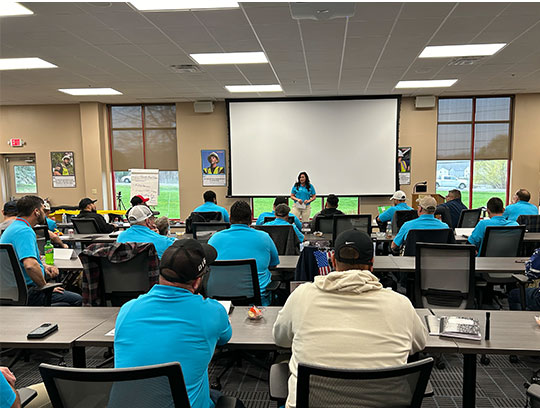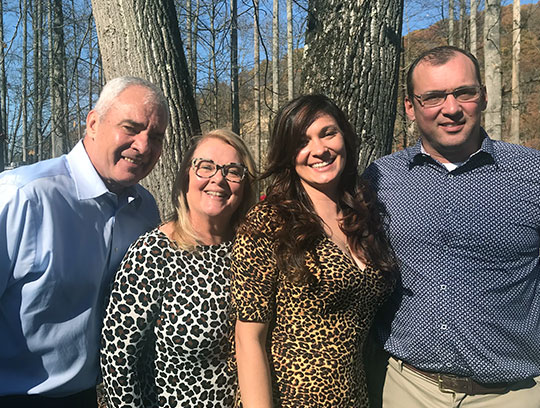The young Craftworker, barely 20 years old, had been on the job for less than two months. Shy by nature, he was quieter than the rest of the crew and preferred to listen more than talk.
Lewis Leadership in Action Spotlight: Director of Safety and Human Performance Alaina Zieglar
What you permit, you promote
The workday started like any other with a sunrise meeting in the yard. After a safety update, pre-trip inspection, and distribution of the day’s assignments, the crews climbed into their trucks and were dispatched to various sites across the region. The young man was growing more accustomed to the new terminology and safety processes, however—as a newcomer—he still had much to learn.
His crew arrived at their designated jobsite and began prepping for the day by setting up the work zone and conducting a pre-job brief. Since starting at Lewis, he had been immersed in rigorous training and was routinely reminded about the importance of proper safety protocol. So, when he witnessed a major safety oversight by his supervisor that day—it stopped him in his tracks.

When we see something that is not correct…and we walk away without saying anything, we have just given permission. We just said it was ok.

The error seemed so obvious that the young Craftworker doubted himself. Perhaps he misunderstood the situation. Maybe he wasn’t seeing things correctly. He momentarily froze… until his training kicked in.
He surveyed the situation, engaged the principles of Press Pause that he’d been taught, pushed aside his fear, and called an All Stop. He briefly worried that he’d overstepped his bounds and could face negative consequences for calling out a superior—but then his supervisor thanked him.

One Empowered Voice
“THAT is what I love about Lewis,” Alaina Zieglar emphatically states as she recounts the story. As Lewis’ Director of Safety and Human Performance, Zieglar points to this scenario as an example of what could have gone wrong but instead went right because an employee was empowered to be brave and refused to look away.
Zieglar continues, “I am proud of that new Lewis employee who observed a serious safety concern and stepped out of his comfort zone to raise a red flag. And I am also proud of his supervisor who has built an improvement-minded, safety-centric culture that encourages his team to speak up without fear of repercussion.” In an industry where complacency and indifference can lead to tragic results, it is no surprise that Zieglar’s favorite Lewis Leadership in Action Principle is “What you permit, you promote.”
With 20 years of experience in employee safety, human performance, and process improvement, Zieglar knows firsthand that missed details can lead to fateful outcomes—but one empowered voice can save the day.

The Danger of Blurred Lines

Alaina Ziegler presents at Lewis' OSHA training
At times, the relationship between permit and promote is very straightforward. If we permit a hasty pre-job inspection, we are allowing a potentially unsafe worksite. If we permit discriminatory language or inappropriate jokes, we are creating a harmful culture.
The concepts of “permit and promote” become murky when they’re vaguely defined or loosely managed, leaving room for personal interpretation, assumed permission and—by default—promotion.
Zieglar explains why the stakes can be very high in vegetation management (VM) if the lines between permit and promote are blurred. “When we see something that is not correct…and we walk away without saying anything, we have just given permission. We just said it was ok.” Taking it a step further, Zieglar continues, “Some may think they’re building rapport with their teams when they say things like, “When I was younger and in your shoes, I would sometimes forget, too…” However, by saying that, we have essentially given permission, and are promoting incorrect, unsafe behavior.”

Leveraging Learning for Positive Promotion
Much research has been published about the connection between inclusion and safety. When employees feel supported, included, and valued, they are more inclined to share their unique perspectives and build a safer workspace. Conversely, if employees fear isolation, reprimand, or ridicule, they are more inclined to keep a low profile and potentially withhold critical information.
Michigan State University refers to diversity, equity, and inclusion in the workplace as important components of “psychological safety” and cites findings from numerous researchers who report increased willingness to share perspectives, opinions, and ideas when they feel safe. The benefits of psychological safety also include an eagerness to learn, “…especially learning from failure, since their failures are not held against them” (Hutchison, 2020, April 8).
These findings align with Lewis’ dedicated usage of After Action Reviews (AARs) following routine work and during storm responses. Developed by the U.S. Army in the 1970s as a replacement for performance critiques, AARs are intended to be open, honest, and inclusive. Whereas performance critiques can be punitive in nature and create division, AARs seek to teach and unify.
Zieglar considers AARs to be a key component of Lewis’ leading safety culture because the process promotes positive reflection, curiosity, and courage—components that fuel the engine of learning. AARs also reduce risk, incidents, and potential remorse. “Silence can be dangerous and lead to lifelong regret. I don’t want anyone to be in a position where they see an at-risk situation, don’t feel like they can say anything, and then someone is injured or worse. That is a horrible feeling that does not have to happen.”

Rooted in Principle

Alaina with her Father, Mother and Brother
Zieglar’s belief that “what you permit, you promote” can be traced back to her upbringing in rural Pennsylvania. Zieglar’s parents embedded accountability, hard work, and dependability into their parenting. “I was raised to honor my commitments and give 110%. We were taught to be responsible for our actions, which provided an important understanding of expectations” Zieglar reflects.
In the Zieglar household, those expectations also included a constant pursuit of learning. Raised to take on any task, Zieglar was given the chance to learn and thrive in multiple settings, whether that was in the garage with her father or at the theatre with her mother. Thankful for this spectrum of opportunities, Zieglar finds that she’s able to relate to a variety of people regardless of gender, age, orientation or race. She is equally comfortable talking fishing or fashion, and can swap her hardhat for heels without blinking an eye.

The Element of Surprise

This is an exciting time at Lewis. We are shepherding a transformative merging of Human Performance, equipment modernization, and technological advancements. We are using cutting-edge practices that Lewis has pioneered in conjunction with gold-standard programs with industry partners.

Zieglar regards her ability to quickly switch gears as a valuable skill. In fact, catching folks off-guard with her wide range of expertise, knowledge, and interests is something that she clearly enjoys—especially as a woman in VM.
“As a safety expert in a traditionally male field, I embrace the element of surprise. When I attend a meeting or visit a job site, I know some are wondering, ‘What is she going to say? What does she know about this?’” Zieglar continues, “However, when they learn about my experiences in several sectors, my ability and agility to pivot between talking with customers and crews, and the new perspectives and processes I bring to this role—there is mutual appreciation for what we can accomplish together.”
Zieglar again attributes her comfort in multiple settings to her parents. She learned at an early age that being a female wasn’t an excuse to get out of anything. In fact, Zieglar learned many activities and skills like baling hay, working on cars, and hunting because they were important to learn as a person—not just a female. Her parents did not permit an “I can’t do this” attitude and instead promoted an “I can do this” mindset. Zieglar brings those same expectations to safety. “The Safety Department is not going to say, ‘It’s not possible.’ We are going to say, ‘We can do this,’ and recruit others to join us.”

Passionate about Safety
Zieglar’s passion for Safety and Human Performance cannot be mistaken or contained, and her tireless drive for progress is contagious. “This is an exciting time at Lewis,” she enthusiastically states. “We are shepherding a transformative merging of Human Performance, equipment modernization, and technological advancements. We are using cutting-edge practices that Lewis has pioneered in conjunction with gold-standard programs with industry partners.”
Zieglar can often be found engaging with crews in the field, joining GFs in training programs at corporate headquarters, or leading the weekly, company-wide Safety Call. When Zieglar isn’t meeting with Craftworkers across Lewis’ growing footprint, she’s working with her Safety team on the roll-out of best practices—such as the relaunch of Lewis’ ‘9 to Know’ safety protocol—or pursuing new innovations in safety technology.
Under Zieglar’s leadership, safety isn’t a sedentary term found in a dusty manual. Safety resides in the important connection between permit and promote. It’s the living link between principles and practice. And it’s the firm commitment made between Lewis crews and the customers they proudly serve.

Safety resides in the important connection between permit and promote. It’s the living link between principles and practice.




